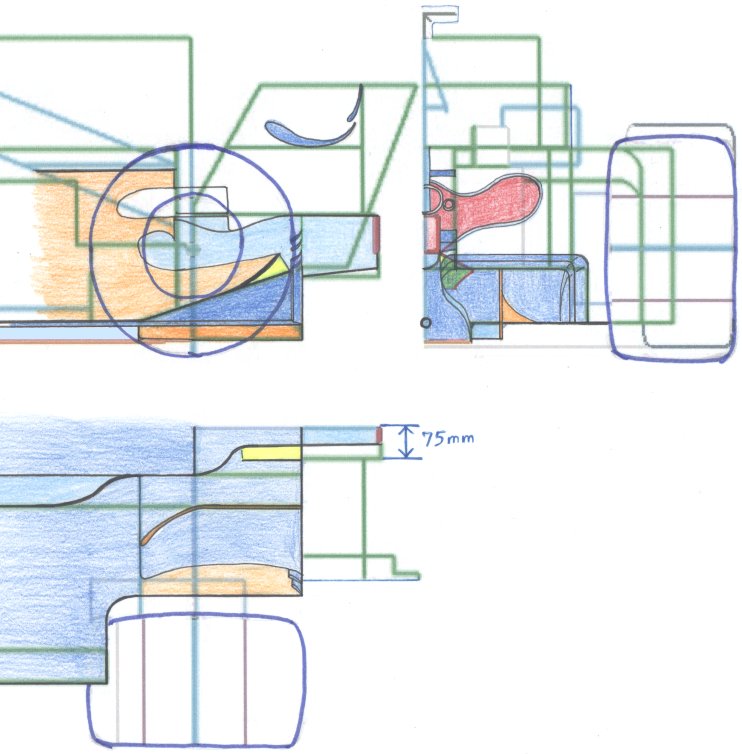McLaren MCL33 text & illustration by tw
(This page was described from February 23rd to March 15th, 2018.)
This season, McLaren will be equipped with Renault's power unit for the first time.
On February 23, 2018, McLaren announced the 2018 machine [MCL 33].
For the picture of [MCL 33] please refer to F1-Gate.com.
Then, from my view of the car body, I will write my opinion.
The former can reduce the adverse effect of the temperature exerted by the exhaust heat of the engine on the compressor.
In the latter, the engine can be laid slightly ahead of the car body.
For this reason, much of McLaren's development resources this year should have been spent on new packaging layout.
Taking that into consideration, it may be difficult to challenge the top group during this year.
[MCL 33] does not adopt Mercedes' High Mount Wishbone nor Ferrari's side pod lift reduction intake.
I looked for the identity of the aerodynamic concept of [MCL 33].
The undercut of the side pod is very deep, and two very long slits are cut at the both ends of the under plate in the front and back.
These two elements will work in sets.
I will describe it in more detail.
In [MCL 33], the portion which becomes the maximum width of the undercut on the side pod side surface is the rearward side, and the flow velocity on the side pod side surface increases to this position.
Utilizing that air current, the amount of air that the bottom of the under panel sucks in from the side of the vehicle body should be tuned to be idealized by the long slit.
And the other point of attention is that the sum of each intake opening area is small.
Because this area covers the engine intake, the intercooler cooling and the cooling of each element of the hybrid system, it is conceivable that the charging efficiency of each intake is high.
The bottom plate of the side deflector and the design of the front edge of the under panel follow from last year's machine.
Whether or not this is effective, I can not make a decision because I can not get a picture with detailed information, but at least it should have recorded good figures in CFD and wind tunnel.
McLaren has installed many low-profile vanes on the top of the side pod as a method of alleviating the lift of the front part of the side pod upper surface.
This intentionally disturbs the airflow so that the high-speed airflow does not run along the front side of the upper side of the side pod, thereby alleviating the lift.
This is a too simple procedure compared to Ferrari's method, but it is not a key part of the vehicle, so it has the merit of being able to tune many times during the season.
Driver is a combination of Fernando Alonso and Stoffel Vandoorne.
| McLaren MCL33 spec | |
|---|---|
| mass | 733kg (Driver included, fuel not included) |
| Weight distribution | Front 45.4 % : Rear 46.4 % |
| Monocoque | Carbon fiber composite |
| Shift change | Electric hydraulic semi-automatic and seamless shift |
| Clutch | Electric hydraulic carbon multiple disc clutch |
| Transmission | 8th forward gear, 1st reverse gear |
| Ger Box | Carbon fiber composite made vertically |
| Differential | Planetary gear type, multiple plate limited slip clutch differential |
| Suspension | Carbon fiber wishbone, torsion bar spring |
| Electronics | McLaren Applied Technologies, Inc. |
| Steering | Rack & Pinion, electric hydraulic power steering |
| brake | Akebono company brake caliper, master cylinder, carbon disc & pad (rear brake by wire) |
| wheel | Enkei Corporation |
| tire | Pirelli Corporation P Zero |
| Wireless device | Kenwood Corporation |
| Cooling equipment | Calsonic Kansei Corporation |
| Advanced production | Stratasis 3D Printing & Additive Manufacturing |
| Painting | Akzo Nobel car refinish system by Thickens products |
| Renault Sport R.E.18 | |
|---|---|
| mass | 145 kg |
| Amount of exhaust | 1.6 L |
| Number of cylinders | 6 |
| Bank angle | 90 degree |
| Number of valves | 4 per cylinder |
| Maximum speed | 15,000 rpm |
| Maximum fuel flow rate | 100 kg/h (10,500 rpm) |
| Maximum fuel load | 105 kg |
| Fuel injection system | Direct injection (One injector per cylinder, max 500 bar) |
| Turbocharger | Coaxial single stage compressor & turbine |
| Energy regeneration system | |
|---|---|
| battery | lithium ion (20~25 kg) Maximum 4 MJ storage per lap |
| MGU-K | |
|---|---|
| Maximum speed | 50,000 rpm |
| Maximum output | 120 kW |
| Maximum regeneration amount | 2 MJ per lap |
| Maximum release | 4 MJ per lap |
| MGU-H | |
|---|---|
| Maximum speed | 125,000 rpm |
| Maximum output | Unlimited |
| Maximum regeneration amount | Unlimited |
| Maximum release | Unlimited |

Furthermore, the channel is spread obliquely outward on the upper surface of the diffuser, and seems to be able to suck out the air current of the bottom of the car body more.
For this widened width channel, it seems legitimate if it hides on the bottom of the diffuser when seeing the car body from below.
But perhaps this is late to be noticed only by me, perhaps it may be a loophole of common sense in the current F1 machine.